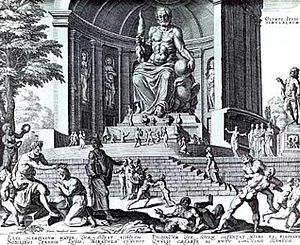
Statue of Zeus at Olympia
Background to the schools Wikipedia
SOS Children, an education charity, organised this selection. See http://www.soschildren.org/sponsor-a-child to find out about child sponsorship.

The Statue of Zeus at Olympia was one of the classic Seven Wonders of the Ancient World. It was made by the famed Greek sculptor of the Classical period, Phidias, circa 432 BC on the site where it was erected in the temple of Zeus, Olympia, Greece.
Description
The seated statue, some 12 metres (39 feet) tall, occupied the whole width of the aisle of the temple built to house it. "It seems that if Zeus were to stand up," the geographer Strabo noted early in the 1st century BC, "he would unroof the temple." Zeus was a chryselephantine sculpture, made of ivory and accented with gold plating. No copy, in marble or bronze, has survived, though there are recognizable but approximate versions on coins of Elis and Roman coins and engraved gems but a very detailed description of the sculpture and the throne was recorded by the traveller Pausanias, in the second century AD. In the sculpture, he was wreathed with shoots of the olive and seated on a magnificent throne of cedarwood, inlaid with ivory, gold, ebony, and precious stones. In Zeus' right hand there was a small statue of crowned Nike, goddess of victory, also chryselephantine, who was, and in his left hand, a sceptre inlaid with metals, on which an eagle perched. Plutarch, in his Life of the Roman general Aemilius Paulus, records that the victor over Macedon “was moved to his soul, as if he had beheld the god in person,” while the Greek orator Dio Chrysostom declared that a single glimpse of the statue would make a man forget his earthly troubles.
The date of the statue, in the third quarter of the fifth century BC, long a subject of debate, was confirmed archaeologically.
According to a legend, when Phidias was asked what inspired him -- whether he climbed Olympos to see Zeus, or whether Zeus came down from Olympos so that Phidias could see him -- the artist answered that he portrayed Zeus according to Book One, verses 528 - 530 of Homer´s Iliad :
-
- ἦ καὶ κυανέῃσιν ἐπ' ὀφρύσι νεῦσε Κρονίων
- ἀμβρόσιαι δ' ἄρα χαῖται ἐπερρώσαντο ἄνακτος
- κρατὸς ἀπ' ἀθανάτοιο μέγαν δ' ἐλέλιξεν Ὄλυμπον.
-
- He spoke, the son of Kronos, and nodded his head with the dark brows,
- and the immortally anointed hair of the great god
- swept from his divine head, and all Olympos was shaken.
Loss and destruction
The circumstances of its eventual destruction are a source of debate: the eleventh-century Byzantine historian Georgios Kedrenos recorded the tradition that it was carried off to Constantinople, where it was destroyed in the great fire of the Lauseion, in 475. Others argue that it perished with the temple when it burned in 425 AD. According to Lucian of Samosata in the later second century, "they have laid hands on your person at Olympia, my lord High-Thunderer, and you had not the energy to wake the dogs or call in the neighbours; surely they might have come to the rescue and caught the fellows before they had finished packing up the swag."
Phidias' workshop rediscovered
Perhaps the greatest discovery in terms of finding out about this wonder came in 1954-1958 with the excavation of the workshop at Olympia where Phidias created the statue. Tools, terracotta molds and a cup inscribed "I belong to Pheidias" were found here, where the traveller Pausanius said the Zeus was constructed. This has enabled archaeologists to re-create the techniques used to make the great work and confirm its date.


